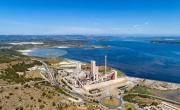Green gas could reduce UK net zero spending by £298 billion
BMA and ADBA report suggests that biomethane can play a key role in the renewable energy push, providing an alternative to fossil gas, providing reliable energy to complement seasonal wind and solar energy.
 New analysis of Britain’s current net zero spending requirements says that nearly £300 billion could be saved by greater use of green gas. This could be the equivalent of £415 for every household each year until 2050 - a 7.5 per cent reduction in project costs.
New analysis of Britain’s current net zero spending requirements says that nearly £300 billion could be saved by greater use of green gas. This could be the equivalent of £415 for every household each year until 2050 - a 7.5 per cent reduction in project costs.
Green gas (biomethane), which is produced by the anaerobic digestion of food waste, farm manures, and industrial by-products, could also save £22 billion in capital and operating costs over the next six years as part of the Government’s clean power goal.
The Role of Green Gas in Net Zero
The Role of Green Gas in Net Zero report, conducted by Business Modelling Applications (BMA) and commissioned by the Anaerobic Digestion and Bioresources Association (ADBA), compared the National Energy System Operator’s (NESO) 2024 net zero plan with an alternative scenario that replaced most costly parts of the transition with green gas.
The results were a £36 billion saving in offshore wind investment and £10.5 billion in onshore wind investment. Smaller savings in nuclear power stations, transmission investment, and hydrogen production were also identified.
Biomethane offers an alternative option to fossil gas as it is easy to store in existing gas grids and storage facilities. As a carbon neutral alternative, the capture of CO2 in green gas production also subtracts from overall emissions.
Discussing the report, Chris Huhne, Chairman at ADBA, said: “Biomethane is the big green battery that can keep us warm and well-lit in dark winters more cheaply than other identified pathways to net zero.”
The report also suggests that by diversifying renewable energy sources, the energy system will become more robust and more likely to meet climate targets. A particular advantage highlighted is that green gas can be generated throughout the country, and doesn’t have specific requirements like sun or wind.
Dr Gareth Mottram, Policy Lead at ADBA, commented on the year-round uses of green gas: “This analysis shows the value of biomethane as a turn-on, turn-off energy source that can significantly cut the costs of operating the whole energy system. Biomethane is the perfect complement to intermittent renewables like solar and wind.”
A biogas roadmap
The report finishes with a 10-point biogas roadmap, highlighting key goals, requirements and advantages of using green gas:
- Building 1000 new biogas plants to shield consumers from high prices
- Replacing synthetic fertilisers with by-product from anaerobic digestion
- Cleaning up the rivers and beaches by treating farm waste through anaerobic digestion
- Creating 18000 new skilled jobs across the UK
- Stopping the Emissions Trading Scheme penalising green gas
- Pledging to establish a plan to decarbonise farming and use farm wastes
- Easing local planning with guidance to every local authority
- Easing permitting and grid connections
- Banning food waste going to landfills and mandating weekly good waste collections
- Curbing climate change from methane
Huhne added: “This study is a wake-up call to look at more cost-effective options for net zero.”
There are increasing calls for bio-based materials and gas to be implemented in the UK’s sustainability strategies, with BB-REG-NET identifying the crucial barriers preventing the adoption of bio-based materials, including regulatory hurdles and infrastructure gaps.






